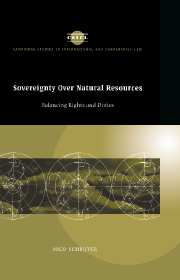Book contents
- Frontmatter
- Contents
- List of boxes, figures and tables
- Preface
- Acknowledgments
- List of abbreviations
- List of main symbols used in UN documents
- Glossary
- Table of cases
- 1 Introduction
- PART I The birth and development of the principle: the UN General Assembly as midwife
- PART II Natural-resource law in practice: from creeping national jurisdiction towards international co-operation
- PART III Balancing rights and duties in an increasingly interdependent world
- Appendices
- Bibliography
- Index
- Books in the series
1 - Introduction
Published online by Cambridge University Press: 23 October 2009
- Frontmatter
- Contents
- List of boxes, figures and tables
- Preface
- Acknowledgments
- List of abbreviations
- List of main symbols used in UN documents
- Glossary
- Table of cases
- 1 Introduction
- PART I The birth and development of the principle: the UN General Assembly as midwife
- PART II Natural-resource law in practice: from creeping national jurisdiction towards international co-operation
- PART III Balancing rights and duties in an increasingly interdependent world
- Appendices
- Bibliography
- Index
- Books in the series
Summary
Objectives of the study
‘Permanent sovereignty over natural resources’ is one of the more controversial new principles of international law that have evolved since World War Two. During this period the decolonization process has taken place and newly independent States have sought to develop new principles and rules of international law in order to assert and strengthen their position in international relations and to promote their social and economic development. The principle of permanent sovereignty over natural resources was introduced in United Nations debates in order to underscore the claim of colonial peoples and developing countries to the right to enjoy the benefits of resource exploitation and in order to allow ‘inequitable’ legal arrangements, under which foreign investors had obtained title to exploit resources in the past, to be altered or even to be annulled ab initio, because they conflicted with the concept of permanent sovereignty. Industrialized countries opposed this by reference to the principle of pacta sunt servanda and respect for acquired rights.
This study has three main objectives. Firstly, to map the evolution of permanent sovereignty over natural resources (hereafter ‘permanent sovereignty’) from a political claim to a principle of international law. The hypothesis is that resolutions of the political organs of the United Nations have been instrumental in this. Secondly, to show that the principle of permanent sovereignty has not evolved in isolation but as part and parcel of other trends in international law.
- Type
- Chapter
- Information
- Sovereignty over Natural ResourcesBalancing Rights and Duties, pp. 1 - 30Publisher: Cambridge University PressPrint publication year: 1997

